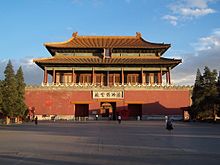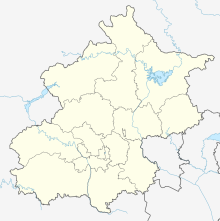Forbidden City
The Forbidden City, now known as the Palace Museum, is a large historical palace and an art museum in the historical center of Beijing, China. The site is a UNESCO World Heritage Site. It is very important to the history and architecture of China. The Forbidden City was the palace of the Emperor of China from the Ming Dynasty to the end of the Qing Dynasty. For almost 500 years, it was as the home of emperors and their houses, as well as the ceremonial and political center of Chinese government.
 The Gate of Divine Might, the northern gate. The lower tablet reads "The Palace Museum" (故宫博物院) | |
| Established | 1925 |
|---|---|
| Location | 4 Jingshan Front St, Dongcheng, Beijing, China |
| Coordinates | 39°54′58″N 116°23′53″E / 39.915987°N 116.397925°E |
| Type | Art museum, Imperial Palace, Historic site |
| Visitors | 16.7 million[1] |
| Curator | Wang Xudong |
| Area | 72 hectares[2] |
| Built | 1406–1420 |
| Architect | Kuai Xiang |
| Architectural style(s) | Chinese architecture |
| Website | en www |
| Part of | Imperial Palaces of the Ming and Qing Dynasties in Beijing and Shenyang |
| Criteria | Cultural: i, ii, iii, iv |
| Reference | 439-001 |
| Inscription | 1987 (11th Session) |
| Forbidden City | |||||||||||||||||||||||
"Forbidden City" in Chinese characters | |||||||||||||||||||||||
| Chinese name | |||||||||||||||||||||||
|---|---|---|---|---|---|---|---|---|---|---|---|---|---|---|---|---|---|---|---|---|---|---|---|
| Chinese | 紫禁城 | ||||||||||||||||||||||
| Literal meaning | "Purple [North Star] Forbidden City" | ||||||||||||||||||||||
| |||||||||||||||||||||||
| Manchu name | |||||||||||||||||||||||
| Manchu script | ᡩᠠᠪᡴᡡᡵᡳ ᡩᠣᡵᡤᡳ ᡥᠣᡨᠣᠨ | ||||||||||||||||||||||
| Romanization | dabkūri dorgi hoton ‘Former inner city’ | ||||||||||||||||||||||
Name
changeThe name "Forbidden City" is a translation of the Chinese name Zijin Cheng (Chinese: 紫禁城; pinyin: Zǐjìnchéng; literally: "Purple Forbidden City"). The name Zijin Cheng was used for the first time in 1576.[3] Another English name for Zijin Cheng is "Forbidden Palace".[4] The word Zi means "purple" in Chinese. It means the North Star. This is because in ancient China it was called the Ziwei Star. In Chinese astrology the North Star was the home of the Celestial Emperor. Because the Forbidden City was the home of the emperor on Earth, the Chinese thought that it was Earth's equivalent of the Ziwei Star. Jin means "Forbidden" in Chinese. This was because no one was allowed to go in or out of the palace without the emperor's permission. Cheng means city.[5]
The Chinese don't call the Forbidden Palace Zijin Cheng anymore. They call it Gùgōng (故宫) now. This means the "Former Palace". The museum that is in the Forbidden City is called the "Palace Museum" (Chinese: 故宫博物院; pinyin: Gùgōng Bówùyùan).
History
changeAfter Zhu Di became the Yongle Emperor, the capital of China was moved from Nanjing to Beijing. In 1406 construction began on the Forbidden City.[5] The construction of the palace went on for over 14 years and more than a million workers had to work on building it.[6] (1406-1420)
References
change- ↑ 故宫2017年接待观众逾1699万人次 创历史新纪录 (in Chinese). 31 December 2017. Retrieved 24 March 2018.
- ↑ "The Layout of the Imperial Palace". 28 March 2019. Retrieved 30 March 2019.
- ↑ Barmé, Geremie R.; Doar, Bruce G. (2008). The Forbidden City. Harvard University Press. p. 26. ISBN 978-0674027794.
- ↑ Gan, Guo-hui (April 1990). "Perspective of urban land use in Beijing". GeoJournal. 20 (4): 359–364. doi:10.1007/bf00174975. S2CID 154980396.
- ↑ 5.0 5.1 Yu, Zhuoyun (1984). Palaces of the Forbidden City. New York: Viking. p. 18. ISBN 0-670-53721-7.
- ↑ Yang, Xiagui (2003). The Invisible Palace. Li, Shaobai (photography); Chen, Huang (translation). Beijing: Foreign Language Press. ISBN 7-119-03432-4.
Other websites
change

